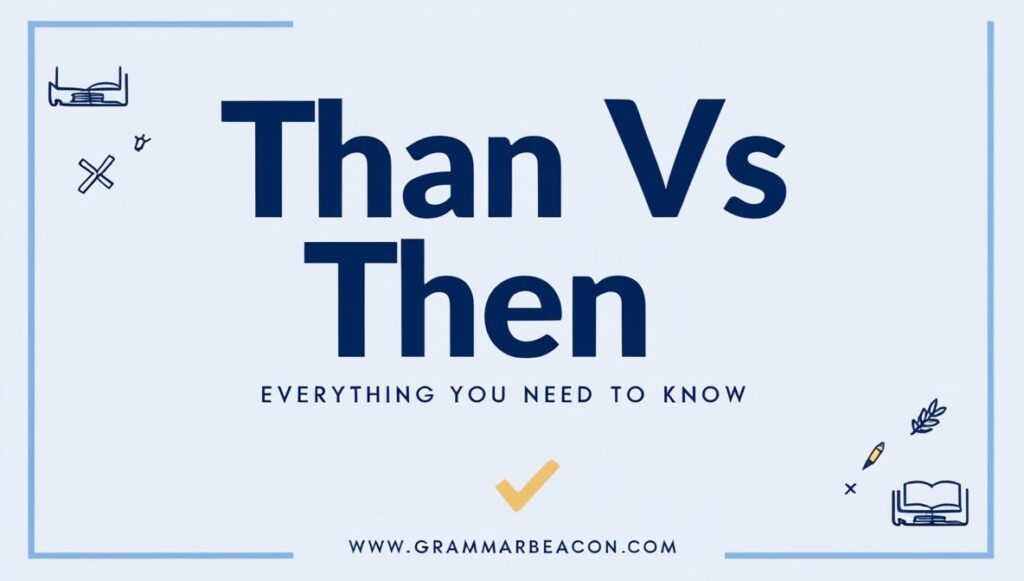Confusing “Than vs Then” is one of the most common slip-ups in English. These two words may look and sound similar, but they play very different roles in sentences. Knowing the difference between than and then is essential if you want to improve your writing and avoid embarrassing mistakes. Whether you’re crafting emails, writing essays, or posting online, using the right word matters.
In this quick grammar guide, you’ll learn exactly how to use than and then correctly with real-life examples, easy rules, and smart memory tricks. We’ll also clear up common grammar mistakes and help you master these tricky terms once and for all. Let’s get started!
Why the Confusion Happens
Many stumble over grammar comparison words because then and than look alike and come up in similar contexts. One acts as a comparison conjunction or preposition, while the other works as an adverb of time or sequence and conditional logic. Getting the proper grammar usage clear can save you from common grammar mistakes that pop up in writing, exams, emails, and social media posts.
When to Use “Than”
Here, we explore when to use than and how it functions in comparisons, such as “better than” or “older than.” You’ll find scenario examples, synonyms, and quick tips to solidify your grasp of comparative structures and sentence structure.
Purpose: “Than” lets you compare two things in terms of degree or quantity.
Examples:
- “She’s smarter than I am.”
- “I have more books than you.”
- “He runs faster than anyone else here.”
Synonyms:
- Instead of “more than,” use “exceeding.”
- Replace “rather than” with “instead of” in preference contexts.
Tips:
- Ask yourself, is this making a comparison? If yes, use than.
- Spot words like “more,” “better,” “less,” and “older”—these often signal than.
- Remember the mnemonic: “Than” = comparison (both have n).
When to Use “Then”
Now, understand when to use then, which often deals with time sequencing, cause and effect, and conditions. We’ll look at scenarios, synonyms, and English grammar tips to help you get it right every time.
Purpose:
- Time sequence: indicates order of events.
- Conditional statements: like “If… then…”
- Cause and effect: links actions and results.
Examples:
- “We ate dinner, then we watched Netflix.”
- “If you study, then you’ll pass.”
- “Back then, I didn’t know how to code.”
Synonyms:
- For sequencing: “afterward,” “next.”
- For conditions: “therefore,” “consequently.”
Tips:
- Ask does it involve timing, ordering, or cause? If yes, it’s likely then.
- Spot sequence words like “first,” “next,” or “later.”
- A mnemonic: “Then” = time (both have e).
Than vs Then: Quick Comparison Table
| Feature | Than | Then |
| Part of Speech | Conjunction / Preposition | Adverb / Conjunction |
| Main Use | Comparison of difference | Time sequence / Condition / Effect |
| Example | “She’s taller than me.” | “We ate, then we left.” |
| Triggers | more, less, rather, better, older | before, afterward, if, causes |
This table makes than vs then usage crystal clear—just check if you’re comparing or sequencing events.
Common Mistakes with Than and Then
Mistake #1: Using “Then” in Comparisons
- ❌ Wrong: “I’d rather go then stay.”
- ✅ Correct: “I’d rather go than stay.”
Tip: Use “than” after words like rather, more, and less.
Mistake #2: Using “Than” for Time or Sequence
- ❌ Wrong: “We’ll meet than.”
- ✅ Correct: “We’ll meet then.”
Tip: If you’re talking about timing, pick then.
Read More: Tweek vs Tweak: Clarifying the Difference
Mistake #3: “Other Then” vs “Other Than”
- ❌ Wrong: “I have no one other then my brother.”
- ✅ Correct: “I have no one other than my brother.”
Tip: “Other than” means except; “other then” is incorrect in most cases.
Other Than or Other Then?
Other Than:
- Means “except” or “besides.”
- Example: “Other than John, nobody showed up.”
Other Then:
- Almost always wrong.
- Only acceptable rarely in rare constructions, e.g. “Other then to laugh, nothing she could do.”
English grammar tips:
- If you mean “except,” it’s other than—easy rule!
More Than or More Then?
More Than:
- Used in numeric or qualitative comparisons.
- Example: “She raised more than \$1,000.”
More Then:
- Incorrect when used like this.
- Might appear in old text as incorrect sequencing, but avoid it.
Tip: Numbers and adjectives = more than.
Rather Than or Rather Then?
Rather Than:
- Signals preference.
- Example: “I’d prefer coffee rather than tea.”
Rather Then:
- Incorrect in this sense.
- Might slip into informal writing but stick to than.
Etymology of Than and Then
Etymology of Than
- Goes back to Old English þanne and Old Norse -enn
- Has always served for comparison.
Etymology of Then
- From Old English þæne (time) and Proto-Germanic roots.
- Rooted in sequencing and time order.
Knowing origins can reinforce proper usage time + “e” = then, comparison + “a” = than.
Grammar Lesson on Than and Then
Dive deeper with a grammar lesson on than and then, exploring their parts of speech, functions, and subtle usage distinctions.
- Than can be a conjunction (“She’s taller than I am”) or preposition (“Nothing other than gold matters”).
- Then acts mostly as an adverb (“I left, then I called”) and sometimes as conjunction in conditional clauses (“If you insist, then fine”).
How to Use Than and Then Correctly
Follow these helpful steps to avoid mistakes:
1. Identify purpose
- Are you comparing things? –> Than
- Are you talking about order or time? –> Then
2. Look for trigger words
- “More,” “less,” “rather,” “other” –> Than
- “Next,” “after,” “if… then” –> Then
3. Use mnemonics
- Than = Comparison (n altNernative)
- Then = Time (t in Time and Then)
4. Proofread strategically
- Scan for wrong usage before hitting send.
5. Practice mini-quizzes
- “She is smarter _ _ me.” (Than)
- “We ate dinner, _ _ we watched TV.” (Then)
Real-World Scenario Examples
Scenario 1: Job Interview Email
- Wrong: “Looking forward to speaking with you more then.”
- Right: “Looking forward to speaking with you then” (since it refers to time).
Scenario 2: Comparing Products
- Wrong: “This phone is better then that one.”
- Right: “This phone is better than that one.”
Scenario 3: Preferences
- Wrong: “I’d rather write then read.”
- Right: “I’d rather write than read.”
Scenario 4: Plot Sequence
- “She found the key. Then, she opened the door.”
Scenario 5: Cause & Effect
- Wrong: “She studied hard then passed exam.” (missing conditional structure if intended)
- Right: “If she studies hard, then she’ll pass.”
Avoiding Confusion: Grammar Clarity Tips
- Keep comparison separate from sequence in mind.
- Change sentence structure often to spot misuse.
- Read writing out loud your ear catches mistakes your eyes miss.
- Run a quick find for “than” and “then” before submitting documents.
Also See: Totalling or Totaling (Which Spelling to Use?)
English Usage: Summary Table
| Usage | Than (Comparison) | Then (Time/Sequence) |
| Comparison words | More, less, rather, other | None |
| Typical position | After comparative modifiers | As connector for time or conditional |
| Example replacement | She loves ice cream more than cake. | First we clean, then we cook. |
FAQs
Yes, you can begin a sentence with then to show sequence or conclusion.
Rarely other than is correct when you mean “besides” or “except.”
No, than always handles comparisons, not sequencing or time.
Final Thoughts
Understanding “Than vs Then” doesn’t have to be hard. Just remember: use than for comparisons and then for time or order. These words may sound alike, but they mean different things. Mixing them up can confuse your message.
Now that you know the difference between than and then, you’ll catch these mistakes before they happen. Keep practicing, read your writing out loud, and double-check tricky spots. With time, using the right word will come naturally. Clear writing starts with small fixes like getting than vs then right every time.
Keep practicing these English grammar tips and you’ll breeze through grammar clarity each time you write.
References for further learning and examples:
- Oxford English Grammar
- Merriam-Webster usage notes
- Grammarly’s official blog on confused words

James Logan is a seasoned blogger and language enthusiast behind Grammar Beacon. With years of experience in grammar and writing, James shares his expertise through insightful and engaging content. His passion for clear communication and linguistic precision shines in every post, making complex grammar concepts accessible and enjoyable for readers. Follow James for expert advice and tips to refine your writing skills.







